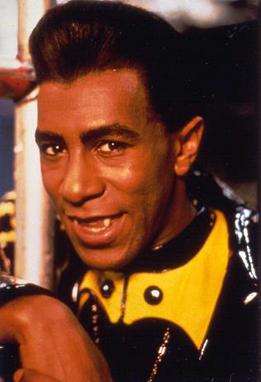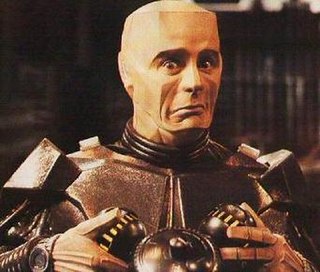
Red Dwarf is a British science fiction comedy franchise created by Rob Grant and Doug Naylor, which primarily consists of a television sitcom that aired on BBC Two between 1988 and 1999, and on Dave since 2009, gaining a cult following. The series follows low-ranking technician Dave Lister, who awakens after being in suspended animation for three million years to find that he is the last living human, and that he is alone on the mining spacecraft Red Dwarf—save for a hologram of his deceased bunkmate Arnold Rimmer and "Cat", a life form which evolved from Lister's pregnant cat.

Arnold Judas Rimmer is a fictional character in the science fiction sitcom Red Dwarf, played by Chris Barrie. Rimmer is characterised as a second-class technician of the mining ship Red Dwarf. Portrayed as snobbish, pedantic, and self-centred, Rimmer is unpopular with his crewmates and is often the target of insults and general ridicule.

Cat is a fictional character in the British science fiction sitcom Red Dwarf. He is played by Danny John-Jules. He is a descendant of Dave Lister's pregnant pet house cat Frankenstein, whose descendants evolved into a humanoid form over three million years while Lister was in stasis. As a character he is vain and aloof, and loves to dress in extravagant clothing. He is simply referred to as "Cat" in lieu of a real name.

David Lister, commonly referred to simply as Lister, is a fictional character from the British science fiction situation comedy Red Dwarf, portrayed by Craig Charles.

Kryten is a fictional character in the British science fiction situation comedy Red Dwarf. The name Kryten is a reference to the head butler in the J.M. Barrie play The Admirable Crichton. Originally referred to as a Series III mechanoid, he is later described as a 4000 Series, or Series 4000.

Kristine Z. Kochanski is a fictional character from the British science fiction situation comedy Red Dwarf. Kochanski was the first console officer in the navigation chamber on board the spaceship Red Dwarf. As well as appearing in the television series, she is also a major character in the Red Dwarf novel Last Human. In series 1, 2, and 6 she was played by Clare Grogan until producers deemed Grogan 'too old' for the role, and the character was then played by Chloë Annett for series 7 and 8, and the 2009 special Back to Earth.

Better Than Life is a science fiction comedy novel by Grant Naylor, the collective name for Rob Grant and Doug Naylor, co-creators and writers of the Red Dwarf television series, on which the novel is based. The main plotline was developed and expanded from the Red Dwarf episode of the same name, as well as the Series 3 and 4 episodes: White Hole, Marooned, Polymorph, and Backwards.

"Polymorph" is the third episode of science fiction sitcom Red Dwarf Series III, and the fifteenth in the series run. It premiered on the British television channel BBC2 on 28 November 1989. It is considered by some to be the series' best. Written by Rob Grant and Doug Naylor, and directed by Ed Bye, the episode has the crew fighting a shapeshifting, emotion-stealing creature. It is the only Red Dwarf episode to feature a pre-credits warning about the content. The episode was re-mastered, along with the rest of the first three series, in 1998.
"Camille" is the first episode of science fiction sitcom Red Dwarf Series IV, and the nineteenth episode in the series run. It was first broadcast on the British television channel BBC2 on 14 February 1991. The episode was planned to be shown third, but was moved forward in the schedule to be shown on Valentine's Day. Written by Rob Grant and Doug Naylor, and directed by Ed Bye. The episode, a parody of the film Casablanca, sees Kryten rescue and fall in love with an android who appears to be the same model as himself.

"Terrorform" is the third episode of science fiction sit-com Red Dwarf Series V and the twenty seventh in the series run. It was first broadcast on the British television channel BBC2 on 5 March 1992. It was written by Rob Grant and Doug Naylor, and was directed by Juliet May. The episode's plot has the Red Dwarf crew rescuing Rimmer from a terraformed moon based on his own psyche.

"Quarantine" is the fourth episode of science fiction sitcom Red Dwarf Series V and the twenty eighth in the series run. It was first broadcast on the British television channel BBC2 on 12 March 1992. The episode, fifth to be filmed, was the first one to be solely directed by Rob Grant and Doug Naylor. The episode has Rimmer contracting a holo-virus and turning against the rest of the crew.
"Emohawk: Polymorph II" is the fourth episode of the British science fiction sitcom TV show Red Dwarf VI and the 34th in the series run. It was first broadcast on BBC2 on 28 October 1993. Written by Rob Grant and Doug Naylor and directed by Andy de Emmony, the episode features the crew again being hunted by a polymorph. The first appearance of these creatures was in the series III episode "Polymorph". Also returning in this episode are Duane Dibbley from "Back to Reality" and Ace Rimmer from "Dimension Jump".

"Stoke Me a Clipper" is the second episode of science fiction sit-com Red Dwarf Series VII and the 38th in the series run. It was first broadcast on the British television channel BBC2 on 24 January 1997, was written by Paul Alexander and Doug Naylor, and was directed by Ed Bye. It was the first episode to involve a writer other than co-creator/writers Grant or Naylor.

"Ouroboros" is the third episode of science fiction sitcom Red Dwarf Series VII and the 39th in the series run. It was first broadcast on the British television channel BBC2 on 31 January 1997. Written by Doug Naylor and directed by Ed Bye, it was the first episode not to feature Arnold Rimmer, and also the first to feature Kristine Kochanski as a regular character, having only appeared previously as a minor recurring character.

"Blue" is the fifth episode of science fiction sitcom Red Dwarf Series VII and the 41st in the series run. It was first broadcast on the British television channel BBC2 on 14 February 1997, was written by Kim Fuller and Doug Naylor, and was directed by Ed Bye. Until Red Dwarf: Back to Earth, it was the last episode to feature the hologram Rimmer.
"Beyond a Joke" is the sixth episode of science fiction sitcom Red Dwarf Series VII and the 42nd in the series' run. It was first broadcast on the British television channel BBC2 on 21 February 1997. The script was written by Robert Llewellyn and Doug Naylor, and was directed by Ed Bye.

"Backwards" is the first episode of science fiction sitcom Red Dwarf Series III, and the thirteenth in the series run. It premiered on the British television channel BBC2 on 14 November 1989. Written by Rob Grant and Doug Naylor, and directed by Ed Bye, the episode has the crew travel to an alternate Earth where time runs backwards.

"Entangled" is the fourth episode of science fiction sitcom Red Dwarf series X, originally broadcast on the British television channel Dave on 25 October 2012. Lister loses Rimmer in a game of poker to a group of "biologically engineered garbage gobblers", and in return gets an unwanted gift: a groinal exploder programmed to detonate in 24 hours unless Lister pays his debts. Meanwhile, Kryten and Cat become quantum entangled and do everything in perfect unison.

"Krysis" is the fifth episode of Red Dwarf XI and the 66th in the series run. Originally broadcast on the British television channel Dave on 20 October 2016, it was made available accidentally on 13 October 2016 on UKTV Play, releasing a day earlier than intended.




















